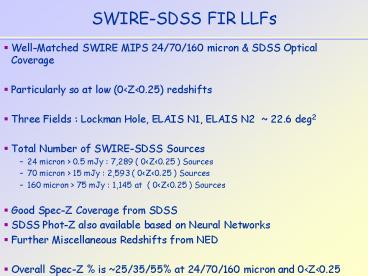SWIRE-SDSS FIR LLFs PowerPoint PPT Presentation
Title: SWIRE-SDSS FIR LLFs
1
SWIRE-SDSS FIR LLFs
- Well-Matched SWIRE MIPS 24/70/160 micron SDSS
Optical Coverage - Particularly so at low (0ltZlt0.25) redshifts
- Three Fields Lockman Hole, ELAIS N1, ELAIS N2
22.6 deg2 - Total Number of SWIRE-SDSS Sources
- 24 micron gt 0.5 mJy 7,289 ( 0ltZlt0.25 ) Sources
- 70 micron gt 15 mJy 2,593 ( 0ltZlt0.25 ) Sources
- 160 micron gt 75 mJy 1,145 at ( 0ltZlt0.25 )
Sources - Good Spec-Z Coverage from SDSS
- SDSS Phot-Z also available based on Neural
Networks - Further Miscellaneous Redshifts from NED
- Overall Spec-Z is 25/35/55 at 24/70/160
micron and 0ltZlt0.25
2
24 micron
SWIRE-SDSS
Imperial/IRAS FSC z-cat
Shupe 98 (IRAS)
Marleau 07 (Spitzer FLS)
Rodighiero (sub) (Spitzer GOODS/VVDS)
3
70 micron
SWIRE-SDSS
Imperial/IRAS FSC z-cat
Saunders 90 (IRAS)
Takeuchi 03 (IRAS)
4
160 micron
SWIRE-SDSS
Takeuchi 06 (ISO)
5
SWIRE-SDSS FIR LLF
- The homogeneity, quality, well-characterized
limits as well as the sheer size of the
SWIRE-SDSS database allow a relatively
straighforward estimate of the FIR Local
Luminosity Function down to flux levels order(s)
of magnitude fainter than IRAS (albeit over a
smaller area) - Ample opportunity to extend such a study
- Higher redshift ( 0.25 lt Z lt 0.5 )
- New spectroscopic observations of complete
samples - Herschel observations of same fields at 100-500 µm
6
SWIRE-SDSS Workflow
- Download Input Catalogs SDSS (Pub) , IRSA (Pub)
, IRSA (SWIRE) , SSC (Pub) , WSA (ESO),, NED
(Pub) - Source Identification based on position and
flux matching, e.g. Nearest-Neighbor or
Likelihood Ratio - Quality Control based on several SWIRE SDSS
flags - Source Characterization Star/Galaxy
- Phot-z calculation following an optimized
procedure (TBD skipped so far in favor of SDSS
NED phot-z) - Completeness Reliability Analysis of all
previous steps - Finally Ad Hoc Science Analysis (e.g. 1/Vmax)
PowerShow.com is a leading presentation sharing website. It has millions of presentations already uploaded and available with 1,000s more being uploaded by its users every day. Whatever your area of interest, here you’ll be able to find and view presentations you’ll love and possibly download. And, best of all, it is completely free and easy to use.
You might even have a presentation you’d like to share with others. If so, just upload it to PowerShow.com. We’ll convert it to an HTML5 slideshow that includes all the media types you’ve already added: audio, video, music, pictures, animations and transition effects. Then you can share it with your target audience as well as PowerShow.com’s millions of monthly visitors. And, again, it’s all free.
About the Developers
PowerShow.com is brought to you by CrystalGraphics, the award-winning developer and market-leading publisher of rich-media enhancement products for presentations. Our product offerings include millions of PowerPoint templates, diagrams, animated 3D characters and more.

